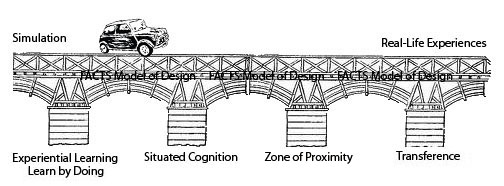
ANALYTICAL THINKING
Evidence of Analytical and Integrative Thinking |
| Reflections on Coursework and Products |
| Conceptual Framework Narrative |

Graphic Explaination Connecting from simulation to reality, this has been the driving force of many researchers to connect practice to real, job related activities. In my expanding research, I have found my thinking is influenced by understanding that learning is situated in context, learning is experiential, one learns best by doing and the importance of role of transfer. The combination of these ideas has comes from my own experiences in the classroom and my coursework throughout my doctoral program. My experiences as a 20 year veteran classroom teacher have given me an insightful perspective and I believe teaching is a field of doing. New teachers benefit from the advice and expertise of an established instructor, but only by being in the classroom and experiencing firsthand a classroom setting can a teacher hope to be successful. These situational settings help a teacher to gain understanding of specific contextual situations. It is the goal of all teachers to transfer difficult situations to positive teachable moments. The image I have chosen to represent my thinking is a bridge. The bridge component in its entirety represents the structured transfer of learning by using a virtual environment to move from a simulation to a real world experience. On the left side of the bridge is the simulation. When using the simulation, the student through situated learning gains experiences to a concept. The goal of the learned experience is to transfer that knowledge to a real event, the right side of the bridge. This guided experience motivates the learning to make good choices when encountering similar situations in their reality. The roadbed represents the design aspect of the careful combination of classroom, curriculum and instruction. Through the FACTS model of lesson design as detailed by Norton and Wiburg (2002), learners navigate experiences designed in situated authentic problems. These situated authentic problems motivate the learner and target learning to real world tasks. Through the Zone of Proximal development the student’s use of the virtual experiences, which are safe and guided, transfers that knowledge to new unaided learning circumstances. Bridging the gap between simulations and real life experiences, this is a phrase kept repeating to myself about my research interests. Because of this thinking, and repetitions of those ideas and phrases, I have found and area I wish to explore. I aim to explore bridging the research gap between elementary students and college student’s use of a virtual environment for learning, and bridging a gap in understanding between virtual tools and transference of knowledge. |